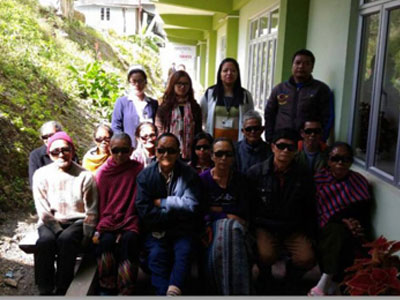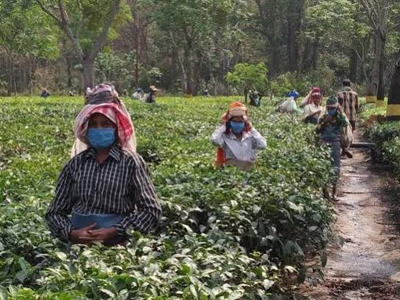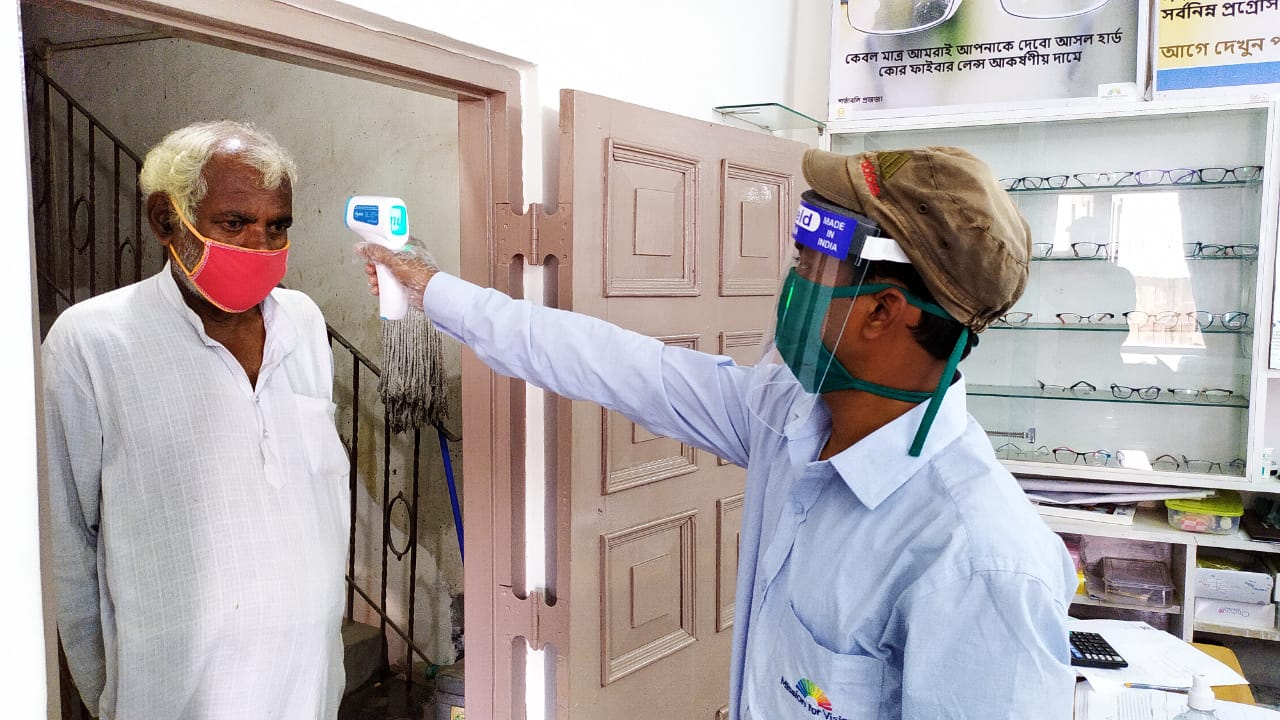Boosting VC Performance in COVID-19 Times
Created By: Franklin Daniel

Even though COVID-19 brought an array of daunting challenges across all industries, the health sector has been able to adapt and respond quite effectively. Eye health in particular has witnessed a fair share of strategies that have been tried and tested to make sure they work well on the ground.
During this hour of need, the commitment and dedication of our eye hospital partners is quite commendable. They ensured that though in the beginning they were providing emergency care only, quickly they all adapted to provide uninterrupted quality eye health services across the care spectrum that we all are known for.
Vision Centre (VC) Approach – The Best Strategy
Community outreach camps are temporarily suspended and transportation is also affected in most parts of the country. The eye health needs of the community remain unaddressed in this scenario and in this perspective, it is primary eye care through vision centres which is the only approach for meeting the unmet demand. Eye health experts consider Vision Centres (VC) as the best approach to carry out community work in the absence of camps and furthermore they are also the only available source for the community to avail quality services1,2. Overall, the lack of screening camps, anxiety among the patients to visit hospitals, restricted transportation and frequent lockdowns made patients turn towards eye centres that are closest to them.
From the service provider standpoint, the Vision Centre is the best strategy in the present scenario that connects the community and primary eye care services seamlessly. Therefore, there is a greater need for effective strategies that enhance the footfall of patients to the Vision Centre. It will help the management of these centres to provide quality services and simultaneously take care of the expenses incurred in running a Vision Centre.
Based on our past experience and the feedback received through our Mission Jyot programme, we developed the following 10 strategies that can lead to a significant improvement in the performance of a Vision Centre.
.jpg)
Ten strategies to improve Vision Centre (VC) performance during COVID-19 pandemic:
1. Regular communication with local leaders/officials: It is extremely important to inform the local leaders and relevant stakeholders about the reopening of the VC and the protocols that our VCs follow in line with the government approved guidelines. This is primarily because permission from local officials is equally important alongside the state government rules and regulations. In addition, they will keep us informed of any new COVID-19 cases reported in the surrounding villages or any other important update. Eventually, they also become our well-wishers to refer patients who require eye health services in that particular area.
2. Be in touch with your old patients: Each VC has a register in which the patients’ details are maintained including the contact details, diagnosis, treatment details, etc. The VC Staff need to select patients based on the following conditions
- The duration of their last visit
- Diagnosis
- Vision
- Age
- Location (nearby ones should be first preference)
- Last advice given.
Patients who had one eye operated, purchased spectacles a year back and those who were advised but did not purchase the spectacles are the ones who require a follow-up call. The Community Health Worker (CHW)/Staff at the VC can call these patients and inform them about the reopening of the VC and apprise them that they had visited earlier and it is time for a follow-up. This would certainly ensure greater footfall and we can ensure complete treatment end-to-end.
3. Publicising the safety protocols of the VC: Along with the practice of good safety protocol, VCs need to publicise it by way of creating banners and posters. This will include explaining the protocol that we follow in the centre; how our staff are trained to handle this situation; what precautionary measures are taken to protect the patient, etc. The methods can include placing a big hoarding/banner outside the VC and important locations, daily newspapers leaflets/inserts, etc. This will certainly build confidence among the patients and generate awareness among the people.
4. Communication with the Government’s Primary Health Care (PHC) staff: The Accredited Social Health Activist (ASHAs), Auxiliary Nurse Midwife (ANMs), and Integrated Child Development Service (ICDS) staff have a strong hold and connect with the communities. Many of them still carry out activities in the field during this pandemic. Each VC location has at least 20 to 30 ASHAs and 3 to 5 ANMs. They should be informed about the Vision Centre reopening and it is also important to reiterate the safety protocol we follow at the Vision Centre. It would also be a kind and good gesture to invite them to visit the centre and get their eyes checked themselves. A happy PHC staff can ensure that the word spreads quickly among the community and they become a valued ambassador in this process.
5. WhatsApp/Online/Tele-meeting with stakeholders: Each VC has its supporters and it could be local NGOs, neighbours, club members, community leaders, headmasters of different schools and the beneficiaries. They can bring enormous changes in the behaviour of the catchment population and they are our customers as well. A formal or scheduled meeting is necessary for them. It is equally important to include senior staff from the hospital in the meeting. Explain to them about the challenges, training provided to staff, PPE procurement, safety measures, etc. It would also be good to be honest with them and state the help expected from them and how can they can be involved in the outreach and awareness process.

6. Identify, motivate, and effectively use the volunteer/community members: There is a need to identify the different people who were a part of the outreach process. These can be camp organisers, volunteers, loyal patients and supporters who have been involved in organising camps earlier. They need to be trained and made aware about the protocols in organising camps, challenges pertaining to government orders, safe distancing, transportation, etc. Request these individuals to refer patients to the VC directly instead of waiting for the camps.
7. Use targeted publicity – more frequently and periodically: The locations where auto-rickshaws are allowed, the staff need to use them for outreach and awareness creation activities. Using them systematically on particular days (local market days), important landmarks (religious centres) is advisable. Using group SMS, sharing video clippings, WhatsApp messages and social media platforms is a good way to communicate with the target audience.
8.Take help from direct walk-in patients to spread the news: It is important to take the help of walk-in patients. While ensuring that they are provided with high-quality services, do make them understand that they are examined with all the required precautions. It would be advisable to request them to refer their immediate family members, neighbours, etc. and ask them to share their own personal experience with them.
9. Explore possibility of appointment system: Overcrowding in the centre may put-off some patients, so it would be good to use an appointment system. This system will help greatly in managing the crowds at the centre and it will also put the communities at ease with regards to the protocols being followed appropriately. You can set up appointments by way of telephone or by placing a notice in the waiting area. This will help VC staff to spread the patient flow throughout the VC hours.
10. Train your staff periodically: Last but not the least, the VC staff need to be trained more frequently. They should also be monitored to check if they are using Personal Protective Equipment (PPE) properly. This helps the VC staff to keep updating their knowledge about the precautions that they should follow during this challenging period for their own and patients’ safety.
Conclusion:
No one expected that this pandemic would cause such an impact. However, the eye health sector’s quick response and adaptation to the ‘new normal’ has been quite a relief. Over the past four months, many strategies have evolved, but one strategy that has worked well is the Vision Centre approach. This is a viable solution to reach out to the community and link them with primary eye health care. The steps mentioned above can be customised based on the region and the local guidelines issued in the particular area. The managers of the Vision Centres can experiment all/few of them and see the results. Apart from the above-mentioned steps, motivation to the staff and proper usage of guidelines and monitoring will add more value to the Vision Centre programme.
About the Author: Franklin Daniel is a General Manager for MFV's Vision Centre programme. He comes with 28 years of experience in eye health and rehabilitation field. At MFV, he is responsible for expansion and strengthening of MFV’s Vision Centre programme.
1.https://www.youtube.com/watch?v=dqablXhJETM&feature=youtu.be,
2. https://www.youtube.com/watch?v=vRPaCsxLozg&feature=youtu.be
SHARE NOW:
RELATED ARTICLES

No Compromise on Quality
Here is a story that reiterates the importance of maintaining the highest quality standards when it comes to delivering eye care.
Read More
Eye Screening of Tea Tribes in Assam
Here is an article that explores the challenges in delivering eye care to Tea Tribes in Assam
Read More
Ounce of prevention - Worth a pound of cure
Debashis narrates his experience of working with Vision Centre staff amind the COVID-19 pandemic
Read More